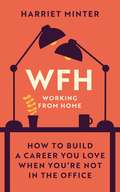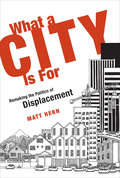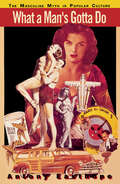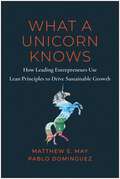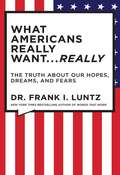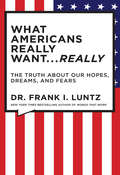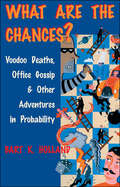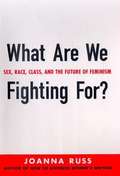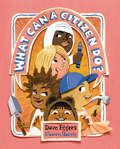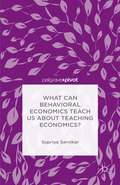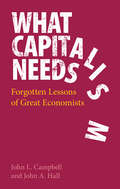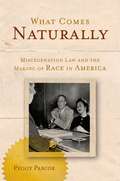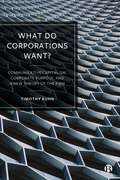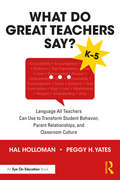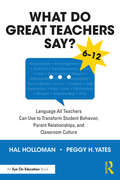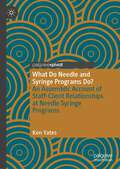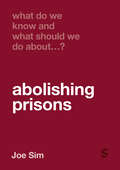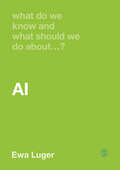- Table View
- List View
WFH (Working From Home): How to build a career you love when you're not in the office
by Harriet Minter'Harriet Minter offers a one-stop resource for those working from home or those who want to work from home but are still sceptical.' - The Financial Times' . . . a must-read for post-Covid times.' - People Management MagazineThe no bullsh*t guide to getting your work and life on track in the new flexible workplace.Virtually every industry is making lasting changes that will open doors to a more flexible working week. So how do we adjust, thrive and excel in an environment where glitchy daily video conferences are the norm?By turns fierce, funny and highly practical, Harriet Minter will show you the skills to be effective and creative during the day-to-day. Harriet breaks down how to be an inspiring and energising manager (either remotely or to a flexibly working team), how to create and thrive in a high-trust culture (on a small and large scale) and most importantly how to achieve your ambition and propel your career forwards.Packed full of hard-won tricks, tips and tools, Harriet Minter draws on her own experience as a careers coach and adviser to companies on their flexible working culture to help you bring your best self to work - from your living room.
WFH (Working From Home): How to build a career you love when you’re not in the office
by Harriet MinterThe no bullsh*t guide to getting your work and life on track in the new flexible workplace.Virtually every industry is making lasting changes that will open doors to a more flexible working week. So how do we adjust, thrive and excel in an environment where glitchy daily video conferences are the norm?By turns fierce, funny and highly practical, Harriet Minter will show you the skills to be effective and creative during the day-to-day. Harriet breaks down how to be an inspiring and energising manager (either remotely or to a flexibly working team), how to create and thrive in a high-trust culture (on a small and large scale) and most importantly how to achieve your ambition and propel your career forwards.Packed full of hard-won tricks, tips and tools, Harriet Minter draws on her own experience as a careers coach and adviser to companies on their flexible working culture to help you bring your best self to work - from your living room.
WFH (Working From Home): How to build a career you love when you're not in the office
by Harriet MinterThe no bullsh*t guide to getting your work and life on track in the new flexible workplace.Virtually every industry is making lasting changes that will open doors to a more flexible working week. So how do we adjust, thrive and excel in an environment where glitchy daily video conferences are the norm?By turns fierce, funny and highly practical, Harriet Minter will show you the skills to be effective and creative during the day-to-day. Harriet breaks down how to be an inspiring and energising manager (either remotely or to a flexibly working team), how to create and thrive in a high-trust culture (on a small and large scale) and most importantly how to achieve your ambition and propel your career forwards.Packed full of hard-won tricks, tips and tools, Harriet Minter draws on her own experience as a careers coach and adviser to companies on their flexible working culture to help you bring your best self to work - from your living room.(P)2021 Quercus Editions Limited
What a City Is For: Remaking the Politics of Displacement
by Matt HernAn investigation into gentrification and displacement, focusing on the case of Portland, Oregon's systematic dispersal of black residents from its Albina neighborhood.Portland, Oregon, is one of the most beautiful, livable cities in the United States. It has walkable neighborhoods, bike lanes, low-density housing, public transportation, and significant green space—not to mention craft-beer bars and locavore food trucks. But liberal Portland is also the whitest city in the country. This is not circumstance; the city has a long history of officially sanctioned racialized displacement that continues today. Over the last two and half decades, Albina—the one major Black neighborhood in Portland—has been systematically uprooted by market-driven gentrification and city-renewal policies. African Americans in Portland were first pushed into Albina and then contained there through exclusionary zoning, predatory lending, and racist real estate practices. Since the 1990s, they've been aggressively displaced—by rising housing costs, developers eager to get rid of low-income residents, and overt city policies of gentrification.Displacement and dispossessions are convulsing cities across the globe, becoming the dominant urban narratives of our time. In What a City Is For, Matt Hern uses the case of Albina, as well as similar instances in New Orleans and Vancouver, to investigate gentrification in the twenty-first century. In an engaging narrative, effortlessly mixing anecdote and theory, Hern questions the notions of development, private property, and ownership. Arguing that home ownership drives inequality, he wants us to disown ownership. How can we reimagine the city as a post-ownership, post-sovereign space? Drawing on solidarity economics, cooperative movements, community land trusts, indigenous conceptions of alternative sovereignty, the global commons movement, and much else, Hern suggests repudiating development in favor of an incrementalist, non-market-driven unfolding of the city.
What a Man's Gotta Do: The Masculine Myth in Popular Culture
by Anthony EasthopeWhat is masculinity? Drawing on psychoanalysis and an understanding of ideology, Easthope shows how the masculine myth forces men to try to be masculine and only masculine, denying their feminine side. In an original contribution to the understanding of gender, he analyzes masculinity as it is represented in a wide range of mass media --films, television, newspapers, pop music, and pop novels. Why are two men in a John Wayne western more concerned with each other than with the women in their lives? Is aggressive male banter a sign that men hate or love each other? Why does a jealous man always have to see his rival? Written in lively, witty, and accessible style, What a Man's Gotta Do is certain to become controversial but essential reading.
What a Unicorn Knows: How Leading Entrepreneurs Use Lean Principles to Drive Sustainable Growth
by Matthew E. May Pablo DominguezWhat a Unicorn Knows is your company&’s best guide to becoming a well-oiled, high-velocity machine for growth on its way to billion-dollar valuation. Why do some young companies become unicorns, while others don&’t? What a Unicorn Knows is a playbook that offers a field-tested approach to delivering superior customer value and reaching unicorn status by removing the potential inhibitors to organizational scale and speed. Drawing on a mastery of lean-based methods for achieving maximum effect with minimum means, private equity operators Matthew E. May and Pablo Dominguez provide readers with a powerful framework of universally applicable principles that enable any company to effectively accelerate its ability to scale and grow. Called The Unicorn Model™ and built on five foundational principles, the authors deliver a compelling narrative of stories and experiences in an easy-to-remember mnemonic: Strategic speed Constant experimentation Accelerated value Lean process Esprit de corps Drawn from the authors&’ successful track record with a wide variety of unicorn-level companies, What a Unicorn Knows offers a necessary guide for rapid but lasting growth. As more companies than ever vie for unicorn status, your competitive edge will depend on learning from the best.
What About Mozart? What About Murder?: Reasoning From Cases
by Howard S. BeckerIn 1963, Howard S. Becker gave a lecture about deviance, challenging the then-conventional definition that deviance was inherently criminal and abnormal and arguing that instead, deviance was better understood as a function of labeling. At the end of his lecture, a distinguished colleague standing at the back of the room, puffing a cigar, looked at Becker quizzically and asked, “What about murder? Isn’t that really deviant?” It sounded like Becker had been backed into a corner. Becker, however, wasn’t defeated! Reasonable people, he countered, differ over whether certain killings are murder or justified homicide, and these differences vary depending on what kinds of people did the killing. In What About Mozart? What About Murder?, Becker uses this example, along with many others, to demonstrate the different ways to study society, one that uses carefully investigated, specific cases and another that relies on speculation and on what he calls “killer questions,” aimed at taking down an opponent by citing invented cases. Becker draws on a lifetime of sociological research and wisdom to show, in helpful detail, how to use a variety of kinds of cases to build sociological knowledge. With his trademark conversational flair and informal, personal perspective Becker provides a guide that researchers can use to produce general sociological knowledge through case studies. He champions research that has enough data to go beyond guesswork and urges researchers to avoid what he calls “skeleton cases,” which use fictional stories that pose as scientific evidence. Using his long career as a backdrop, Becker delivers a winning book that will surely change the way scholars in many fields approach their research.
The What Americans Really Want...Really: The Truth About Our Hopes, Dreams, and Fears
by Dr. Frank LuntzNo one in America has done more observing of more people than Dr. Frank I. Luntz. From Bill O'Reilly to Bill Maher, America's leading pundits, prognosticators, and CEOs turn to Luntz to explain the present and to predict the future. With all the upheavals of recent events, the plans and priorities of the American people have undergone a seismic shift. Businesses everywhere are trying to market products and services during this turbulent time, but only one man really understands the needs and desires of the New America. From restaurant booths to voting booths, Luntz has watched and assessed our private habits, our public interests, and our hopes and fears. What are the five things Americans want the most? What do they really want in their daily lives? In their jobs? From their government? For their families? And how does understanding what Americans want allow businesses to thrive? Luntz disassembles the preconceived notions we have about one another and lays all the pieces of the American condition out in front of us, openly and honestly, then puts the pieces back together in a way that reflects the society in which we live. What Americans Really Want...Really is a real, if sometimes scary, discussion of Americans' secret hopes, fears, wants, and needs. The research in this book represents a decade of face-to-face interviews with twenty-five thousand people and telephone polls with one million more, as well as the exclusive, first-ever "What Americans Really Want" survey. What Luntz offers is a glimpse into the American psyche, along with analysis that will rock assumptions and right business judgment. He proves that success in virtually any profession demands that we either understand what Americans really want, or suffer the consequences. Praise for Frank Luntz: "When Frank Luntz invites you to talk to his focus group, you talk to his focus group."--President Barack Obama, spoken on June 28, 2007, to a PBS-sponsored focus group following the Democratic presidential debate at Howard University "Frank Luntz understands the American people better than anyone I know."--Newt Gingrich, former Speaker of the House "The Nostradamus of pollsters."--Sir David Frost "America's top companies listen to Frank Luntz because he understands what customers want and what employees think. He has a keen sense of the American psyche and an outstanding command of language that empowers and persuades."--Thomas J. Donohue, President & CEO, U.S. Chamber of Commerce
What Americans Really Want...Really: The Truth About Our Hopes, Dreams, and Fears
by Frank I. LuntzNo one in America has done more observing of more people than Dr. Frank I. Luntz. From Bill O'Reilly to Bill Maher, America's leading pundits, prognosticators, and CEOs turn to Luntz to explain the present and to predict the future. With all the upheavals of recent events, the plans and priorities of the American people have undergone a seismic shift. Businesses everywhere are trying to market products and services during this turbulent time, but only one man really understands the needs and desires of the New America. From restaurant booths to voting booths, Luntz has watched and assessed our private habits, our public interests, and our hopes and fears. What are the five things Americans want the most? What do they really want in their daily lives? In their jobs? From their government? For their families? And how does understanding what Americans want allow businesses to thrive? Luntz disassembles the preconceived notions we have about one another and lays all the pieces of the American condition out in front of us, openly and honestly, then puts the pieces back together in a way that reflects the society in which we live. What Americans Really Want...Really is a real, if sometimes scary, discussion of Americans' secret hopes, fears, wants, and needs. The research in this book represents a decade of face-to-face interviews with twenty-five thousand people and telephone polls with one million more, as well as the exclusive, first-ever "What Americans Really Want" survey. What Luntz offers is a glimpse into the American psyche, along with analysis that will rock assumptions and right business judgment. He proves that success in virtually any profession demands that we either understand what Americans really want, or suffer the consequences.
What Are the Chances?: Voodoo Deaths, Office Gossip, and Other Adventures in Probability
by Bart K. HollandUsing examples drawn from daily life and history, the author explains what probability is and how it works.Our lives are governed by chance. But what, exactly, is chance? In this book, accomplished statistician and storyteller Bart K. Holland takes us on a tour of the world of probability. Weaving together tales from real life—from the spread of the bubonic plague in medieval Europe or the number of Prussian cavalrymen kicked to death by their horses, through IQ test results and deaths by voodoo curse, to why you have to wait in line for rides at Disneyworld—Holland captures the reader's imagination with surprising examples of probability in action, everyday events that can profoundly affect our lives but are controlled by just one number.As Holland explains, even chance events are governed by the laws of probability and follow regular patterns called statistical laws. He shows how such laws are successfully applied, with great benefit, in fields as diverse as the insurance industry, the legal system, medical research, aerospace engineering, and climatology. Whether you have only a distant recollection of high school algebra or use differential equations every day, this book offers examples of the impact of chance that will amuse and astonish.
What are Universities For?
by Stefan ColliniAcross the world, universities are more numerous than they have ever been, yet at the same time there is unprecedented confusion about their purpose and scepticism about their value. What Are Universities For? offers a spirited and compelling argument for completely rethinking the way we see our universities, and why we need them. Stefan Collini challenges the common claim that universities need to show that they help to make money in order to justify getting more money. Instead, he argues that we must reflect on the different types of institution and the distinctive roles they play. In particular we must recognize that attempting to extend human understanding, which is at the heart of disciplined intellectual enquiry, can never be wholly harnessed to immediate social purposes - particularly in the case of the humanities, which both attract and puzzle many people and are therefore the most difficult subjects to justify.At a time when the future of higher education lies in the balance, What Are Universities For? offers all of us a better, deeper and more enlightened understanding of why universities matter, to everyone.
What Are We Doing Here?: Essays
by Marilynne RobinsonNew essays on theological, political, and contemporary themes, by the Pulitzer Prize winner.Marilynne Robinson has plumbed the human spirit in her renowned novels, including Lila, winner of the National Book Critics Circle Award, and Gilead, winner of the Pulitzer Prize and the National Book Critics Circle Award. In this new essay collection she trains her incisive mind on our modern political climate and the mysteries of faith. Whether she is investigating how the work of great thinkers about America like Emerson and Tocqueville inform our political consciousness or discussing the way that beauty informs and disciplines daily life, Robinson's peerless prose and boundless humanity are on full display. What Are We Doing Here? is a call for Americans to continue the tradition of those great thinkers and to remake political and cultural life as "deeply impressed by obligation [and as] a great theater of heroic generosity, which, despite all, is sometimes palpable still."
What Are We Fighting For?: Sex, Race, Class and the Future of Feminism
by Joanna RussA study of the future of feminism calls for a return to the radical roots of feminism's direct political struggle during the 1960s and early 1970s and a move away from the de-politicized focus on women's psychology and personal relations of today.
What Can a Citizen Do?
by Dave Eggers Shawn HarrisA citizen can pick up litterA citizen can pull a weedA citizen can help that critterA citizen can plant a seedA citizen can aid a neighbor A citizen can join a causeA citizen can write a letterA citizen can help change laws . . .Empowering and timeless, What Can a Citizen Do? is the latest collaboration from the acclaimed duo behind the bestselling Her Right Foot: Dave Eggers and Shawn Harris. This is a book for today's youth about what it means to be a citizen.Across the course of several seemingly unrelated but ultimately connected actions by different children, we watch how kids turn a lonely island into a community—and watch a journey from what the world should be to what the world could be.This is a book about what citizenship—good citizenship—means to you, and to us all.
What Can Behavioral Economics Teach Us about Teaching Economics?
by Supriya SarnikarSarnikar cites evidence of frequent misconceptions of economics amongst students, graduates, and even some economists, and argues that behavioral economists are uniquely qualified to investigate causes of poor learning in economics. She conducts a review of the economics education literature to identify gaps in current research efforts and suggests a two-pronged approach to fill the gaps: an engineering approach to the adoption of innovative teaching methods and a new research program to enhance economists' understanding of how learning occurs. To facilitate research into learning processes, Sarnikar provides an overview of selected learning theories from psychology, as well as new data on hidden misconceptions amongst beginning students of economics. She argues that if they ask the right questions, economists of all persuasions are likely to find surprising lessons in the answers of beginning students of economics.
What Capitalism Needs: Forgotten Lessons of Great Economists
by John L. Campbell John A. HallFrom unemployment to Brexit to climate change, capitalism is in trouble and ill-prepared to cope with the challenges of the coming decades. How did we get here? While contemporary economists and policymakers tend to ignore the political and social dimensions of capitalism, some of the great economists of the past - Adam Smith, Friedrich List, John Maynard Keynes, Joseph Schumpeter, Karl Polanyi and Albert Hirschman - did not make the same mistake. Leveraging their insights, sociologists John L. Campbell and John A. Hall trace the historical development of capitalism as a social, political, and economic system throughout the twentieth and early twenty-first centuries. They draw comparisons across eras and around the globe to show that there is no inevitable logic of capitalism. Rather, capitalism's performance depends on the strength of nation-states, the social cohesion of capitalist societies, and the stability of the international system - three things that are in short supply today.
What Children Need
by Jane WaldfogelWhat do children need to grow and develop? And how can their needs be met when parents work? Emphasizing the importance of parental choice, quality of care, and work opportunities, economist Jane Waldfogel guides readers through the maze of social science research evidence to offer comprehensive answers and a vision for change. Drawing on the evidence, Waldfogel proposes a bold new plan to better meet the needs of children in working families, from birth through adolescence, while respecting the core values of choice, quality, and work: ,Allow parents more flexibility to take time off work for family responsibilities; ,Break the link between employment and essential family benefits; ,Give mothers and fathers more options to stay home in the first year of life; ,Improve quality of care from infancy through the preschool years; ,Increase access to high-quality out-of-school programs for school-aged children and teenagers.
What Comes Naturally: Miscegenation Law And The Making Of Race In America
by Peggy PascoeA long-awaited history that promises to dramatically change our understanding of race in America, What Comes Naturally traces the origins, spread, and demise of miscegenation laws in the United States-laws that banned interracial marriage and sex, and which were enacted and applied not just in the South but throughout most of the country, in the West, the North, and the Midwest. Beginning in the Reconstruction era, when the term miscegenation first was coined, Peggy Pascoe traces the creation of a racial hierarchy that bolstered white supremacy and banned the marriage of Whites to Chinese, Japanese, Filipinos, and American Indians, as well as the marriage of Whites to Blacks. She takes readers into the lost world of miscegenation law, showing how legislators, lawyers, and judges used ideas about gender and sexuality to enact and enforce miscegenation laws. Judges labeled interracial marriages "unnatural," marriage license clerks made them seem statistically invisible, and newspaper reporters turned them into sensational morality tales. Taken together, their actions embedded a multiracial version of white supremacy deep in the heart of the modern American state. Pascoe ends not simply with the landmark 1967 case of Loving v. Virginia, in which the U. S. Supreme Court finally struck down miscegenation laws, but with a look at the implications of the ideal of colorblindness that replaced them. Moving effortlessly from the lives of interracial couples, the politicking of the NAACP, and the outraged objections of Filipino immigrants to the halls of state legislatures and rulings of the Supreme Court, What Comes Naturally transcends older interpretations of bans on interracial marriage as a southern story in black and white to offer a stunning account of the national scope and multiracial breadth of America's tragic history of miscegenation laws.
What Do Corporations Want?: Communicative Capitalism, Corporate Purpose, and a New Theory of the Firm
by Timothy Kuhn'Corporate purpose' has become a battleground for stakeholders’ competing desires. Some argue that corporations must simply generate profit; others suggest that we must make them create social change.Leading organization studies scholar Timothy Kuhn argues that this 'either/or' thinking dramatically oversimplifies matters: today’s corporations must be many things, all at once.Kuhn offers a bold new Communicative Theory of the Firm to highlight the authority that creates corporations’ identities and activities. The theory provides a roadmap for navigating that battleground of competing desires to produce more responsive corporations.Drawing on communicative and new materialist theorizing, along with three insightful case studies, this book thoroughly redefines our understandings of what corporations are 'for'.
What Do Great Teachers Say?: Language All Teachers Can Use to Transform Student Behavior, Parent Relationships, and Classroom Culture K-5
by Hal Holloman Peggy H. YatesDo you remember a time when you used the right words at the right moment, and they made all the difference? With the aim of helping you repeat that experience every day, this book provides hundreds of examples of what we call Great Teacher Language, a technique designed to help all teachers use words to transform student behavior and parent relationships. In their years of working at the K-12 levels, educators Hal Holloman and Peggy H. Yates have identified the exact phrases and key words you can use in your classroom to address inappropriate outbursts, a lack of respect and cooperation, student conflict, and more. Great Teacher Language will enable you to transform student behavior, parent relationships, and your classroom culture. This book features 11 Great Teacher Language Word Categories, which you'll learn how to use in terms of self-talk, student talk, and parent talk: Words of Accountability, Words of Encouragement, Words of Grace, Words of Guidance, Words of High Expectations, Words of Hope, Words of Love, Words of Relationships, Words of Respect, Words of Understanding, and Words of Unity. Filled with helpful charts and Great Teacher Language examples, this resource will be one you turn to again and again, and will make a transformational difference for your students, your parents, and you!
What Do Great Teachers Say?: Language All Teachers Can Use to Transform Student Behavior, Parent Relationships, and Classroom Culture 6-12
by Hal Holloman Peggy H. YatesDo you remember a time when you used the right words at the right moment, and they made all the difference? With the aim of helping you repeat that experience every day, this book provides hundreds of examples of what we call Great Teacher Language, a technique designed to help all teachers use words to transform student behavior and parent relationships. In their years of working at the K-12 levels, educators Hal Holloman and Peggy H. Yates have identified the exact phrases and key words you can use in your classroom to address inappropriate outbursts, a lack of respect and cooperation, student conflict, and more. Great Teacher Language will enable you to transform student behavior, parent relationships, and your classroom culture.The book features 11 Great Teacher Language Word Categories, which you'll learn how to use in terms of self-talk, student talk, and parent talk: Words of Accountability, Words of Encouragement, Words of Grace, Words of Guidance, Words of High Expectations, Words of Hope, Words of Love, Words of Relationships, Words of Respect, Words of Understanding, and Words of Unity.Filled with helpful charts and Great Teacher Language examples, this resource will be one you turn to again and again and will make a transformational difference for your middle and high school students, their parents, and you!
What Do Needle and Syringe Programs Do?: An Assemblic Account of Staff-Client Relationships at Needle Syringe Programs
by Ken YatesThis book explores the lived experiences of people who interact with needle and syringe program services in Western Sydney, Australia, including participants and industry workers. It locates the research within the wider context of harm reduction and drug policies. It addresses the question "what do needle and syringe programs do?" and seeks to unpack the agency of human and non-human factors to consider the ‘more than human’ effects of these programmes. Alongside a critical materialist perspective used to interpret the empirical findings, the book demonstrates that needle and syringe programs create new possibilities for engaging with the world by changing the material conditions of illicit drug consumption. It draws on the conceptual contributions of post-humanist thinking from assemblage theory, actor-network theory, and cognate scholarship. Consideration is given to transferable findings and insights for international contexts. The book speaks to scholars and postgraduate students in the areas such as sociology, criminology, social work, critical public health, cultural studies, and related fields.
What Do We Know and What Should We Do About Abolishing Prisons? (What Do We Know and What Should We Do About:)
by Joe SimThis book challenges the myths and misrepresentations that justify the existence of prisons. It traces the history and failure of prison reform over two centuries, addresses a number of key, contemporary issues and argues for the abolition of prisons. It explores: The problem with liberal reformism. The myths around crime, the prison population and prison regimes. People in prison and the harms they experience. The relationship between prisons, punishment and structural inequality. The case for abolishing prisons. Aimed at students, researchers, grassroots organisations, prisoners’ rights activists, policy makers and anyone interested in social justice, its conclusion is clear; there needs to be fundamental and meaningful change. Prisons, the criminal injustice system and structural inequalities need to be radically transformed and abolished if social justice is to be achieved. Written by leading social scientists, the What Do We Know and What Should We Do About...? series offers concise, up-to-date overviews of issues often oversimplified, misrepresented or misunderstood and shows you how to enact change. "Short, sharp and compelling." - Alex Preston, The Observer "If you want to learn a lot about what matters most, in as short a time as possible, this is the series for you."- Danny Dorling, 1971 Professor of Geography, University of Oxford
What Do We Know and What Should We Do About AI? (What Do We Know and What Should We Do About:)
by Ewa LugerThe idea of Artificial Intelligence (AI) has taken the world by storm. From fears over killer robots in sci-fi dystopias, to driverless cars in real life, we are both inspired and horrified by the prospect of an advanced intelligence that is not our own. Could AI take over the world? Will it take all of our jobs? Has Google really created a sentient chatbot, and is AI racing towards human intelligence, or is it just horribly misunderstood? These common questions point us towards an unknown and troubling future. What we do know is that we are in the midst of a hype cycle, with huge amounts of funding and focus galvanising progress. Whether AI truly lives up to this hype remains to be seen, but this once niche idea has suddenly evolved into a global multibillion dollar industry. In this short and accessible book, Ewa Luger explains what we mean when we talk about AI, explores how we got here, describes what we are doing about it, where the field is heading, and where we should go next. ABOUT THE SERIES: The ‘What Do We Know and What Should We Do About...?′ series offers readers short, up-to-date overviews of key issues often misrepresented, simplified or misunderstood in modern society and the media. Each book is written by a leading social scientist with an established reputation in the relevant subject area. The Series Editor is Professor Chris Grey, Royal Holloway, University of London
What Do We Know and What Should We Do About AI? (What Do We Know and What Should We Do About:)
by Ewa LugerThe idea of Artificial Intelligence (AI) has taken the world by storm. From fears over killer robots in sci-fi dystopias, to driverless cars in real life, we are both inspired and horrified by the prospect of an advanced intelligence that is not our own. Could AI take over the world? Will it take all of our jobs? Has Google really created a sentient chatbot, and is AI racing towards human intelligence, or is it just horribly misunderstood? These common questions point us towards an unknown and troubling future. What we do know is that we are in the midst of a hype cycle, with huge amounts of funding and focus galvanising progress. Whether AI truly lives up to this hype remains to be seen, but this once niche idea has suddenly evolved into a global multibillion dollar industry. In this short and accessible book, Ewa Luger explains what we mean when we talk about AI, explores how we got here, describes what we are doing about it, where the field is heading, and where we should go next. ABOUT THE SERIES: The ‘What Do We Know and What Should We Do About...?′ series offers readers short, up-to-date overviews of key issues often misrepresented, simplified or misunderstood in modern society and the media. Each book is written by a leading social scientist with an established reputation in the relevant subject area. The Series Editor is Professor Chris Grey, Royal Holloway, University of London
